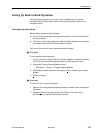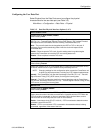
Configuration
3-23
9123-A2-GB20-00
May 2000
Configuring the Physical Interfaces
Characteristics for the following physical interfaces can be configured:
H Network Interface
H User Data Port
Configuring the Network Interface
When configuring the physical characteristics for the network interface, select
Physical from the Network menu (see Table 3-4).
Main Menu
→
Configuration
→
Network
→
Physical
Table 3-4. Network Physical Interface Options (1 of 4)
Line Framing Format
Possible Settings: D4, ESF
Default Setting: ESF
Specifies the framing format for transmitted and received signals on the T1 network
interface.
D4 – Uses D4 framing format.
NOTE: This setting is not recommended by network carriers. False yellow alarms
may occur after traffic has been running and the channel returns to idle, or
when there is light traffic when other settings are selected. ESF format
does not create this problem.
ESF – Uses Extended Superframe framing format.
Line Coding Format
Possible Settings: AMI, B8ZS
Default Setting: B8ZS
Specifies the line coding format for the network interface.
AMI – Uses Alternate Mark Inversion (AMI) line coding format.
B8ZS – Uses Bipolar 8 Zero Substitution (B8ZS) line coding format.
Line Build Out (LBO)
Possible Settings: 0.0, –7.5, –15, –22.5
Default Setting: 0.0
Specifies the line build out for the signal transmitted to the network.
0.0, –7.5, –15, –22.5 – Specifies line build out in dB.


















